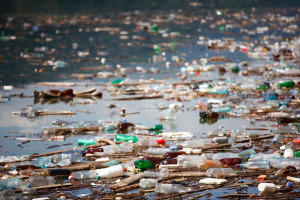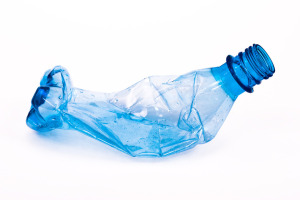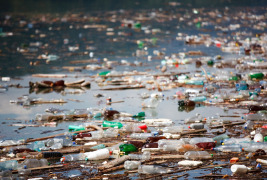Plastic Water Bottles: One-Use Commodities We Do Not Need
Editorial
Ecology Florida
This past March, San Francisco became the first major city in the US to prohibit the sale of plastic water bottles on public property.[5] We commend this positive decision, and encourage Florida municipalities to take similar action.
There are numerous reasons for reducing or (ideally) eliminating the use of plastic bottles for water consumption. At the end of this editorial, you will find research and reference sources and links to several good sites enumerating major reasons for taking this action.
From among the many challenges related to the proliferation of plastic water bottles, three concerns are particularly significant – Environmental, Personal Health, and Culture. The environmental and health challenges are fairly well known and widely reported. The cultural challenges have received somewhat less attention. We’ll consider all three here, with a little extra attention given to cultural concerns. We’ll also suggest some constructive responses to these challenges.

Environmental Concerns
We can begin by recognizing that consuming water in this way is extremely costly. Besides the financial expense (bottled water is more expensive than gasoline, and vastly more expensive than tap water), there is a significant environmental expense.[3]
Take a look at a plastic water bottle. The bottles themselves are made from oil, a nonrenewable resource that is increasingly costly and environmentally risky to extract and refine. It requires about a third of a bottle of oil by volume to produce that bottle. Oil extraction and refining is destructive of the environment, with oil spills being only the most dramatic examples. Bottled water contributes to this destruction to the tune of 1.5 million barrels of oil annually. Added to this is the cost of shipping the bottles from production sites to distribution centers, and finally to retail outlets. Consider for a moment how much shelf-space is devoted to plastic water bottles in your local grocery store, then multiply that by all the stores in your immediate vicinity, then expand your consideration to the stores in our state, our nation, and our world. This gives some idea of the incredible amount of oil and resulting environmental destruction being invested in this commodity.
The environmental costs escalate when we remember that it takes more than 1,000 years for plastic to biodegrade. Here is yet another one-use commodity, that will remain in our ecosystems for a millennium. Worldwatch reports that each year, about two million tons of bottles end up in US landfills. If the empty bottle happens to find its way to an incinerator (rather than a landfill) it will generate toxins, polluting the air, water, and ground. Finally, despite the hoopla about plastic being recyclable, very few bottles (only 20%) are actually recycled – and those that are usually get shipped to underdeveloped countries to be recycled and in some instances dumped into landfills in those countries.[1]
To these environmental costs, we could add, visual pollution and litter, destruction of natural habitats, and the injury or death of animals.
Health Concerns
Another consideration is personal health. There are two issues here. First, unlike tap water (which is regulated by the EPA), bottled water is considered a food, and is regulated by the FDA, which has weaker standards. For example, it is not uncommon for bottled water to have no indication of where the water came from, how it was filtered, or the trace elements it contains. Municipal water systems offer this precise information, yet bottled water does not – even though most bottled water comes from (you guessed it) municipal water systems. Still, you just can’t be sure; and you certainly will not be as sure as you can be about water from your tap.[4] So, with bottled water there is the risk of the unknown, and the necessity to trust the mega-corporations producing this commodity. Just as they are not required to indicate the presence of GMOs in food products, these corporations are not required to indicate the various chemicals and solids found in their water – or even where it comes from.[12]
Even if the water in the bottles is perfectly safe (and it probably is because it is from an EPA regulated municipal water system), for many there are real concerns with the plastic bottles themselves. Besides being a major and ongoing environmental problem, exposure of foods and beverages to plastic is considered by some to be a health concern. Bisphenol A (BPA) is obviously a health issue, and although many manufacturers are getting away from BPA, there are numerous other chemicals in plastic that can contaminate foods and beverages, especially over extended time periods and when exposed to heat.[2]
As reported by MindBodyGreen, “Some of these chemicals are possible endocrine disruptors.”[8] So, just as folks will want to continue to trust the big corporations to have pure water in their under-regulated commodity, they will also want to continue to trust that there will be no long term ill-effects from chemicals in the plastic bottles themselves.

Cultural Concerns
Besides environmental, and health concerns, consideration should also be given to the cultural damage caused by bottled water. This is a tougher topic to engage, because we are profoundly socialized to a reality based on hyper-consumerism and the commodification of virtually all aspects of culture. Bottled water as a major consumer product is now well established as a commodity, and so it is embedded in our reality and largely taken for granted as a normal or “natural” feature of existence. The same could be said of industrially produced food, big-box warehouse stores, theme parks, convenience stores, exurbs, personal transportation devices, and countless other features of contemporary society that compromise the health of cultural ecosystems. Because bottled water, like those other features, is an embedded commodity in a consumer-based socioeconomic system, considering alternatives is difficult – and for some it may be impossible.
In terms of a healthy cultural ecology, the problem here is the commodification of an otherwise community resource, and one made available for very little cost (or no cost at all) to the public. Bottled water separates us from our shared environment and further divorces us from our relationship with and concern for the human and natural communities in which we dwell. Like the multitude of other corporate assaults on healthy cultural ecologies, the commodification of water gives corporations yet another vehicle to disrupt unique cultural ecologies found in cities, towns, villages, neighborhoods, boroughs, and other discrete expressions of communal human life.
As bottled water advanced into the market and global consciousness, beginning in the USA in the 1990s, awareness of and interest in community water systems began to decline, at least in part due to the aggressive marketing of bottled water as superior to tap water. Curiously, this marketing approach is seldom seen today, probably because it was such a masterful success. Of course, much of the bottled water sold today comes from municipal systems, and bottled water has fewer regulations than tap water. So, the idea that bottled is better than tap is largely a matter of faith, but it is a faith developed by powerful marketing systems and today widely accepted as a fact. As a result, many people (especially those who can afford to purchase bottled water routinely) are convinced that bottled water is not only better than tap it is a virtual necessity.
The down side of this is that here, as in countless other areas of cultural life, corporations have replaced local communities as the source of meaning and value – and in this case sustenance. The widespread notion that commodified water is better than local tap water is simply another expression of the hegemony of corporations over culture, and their capacity to marginalize, discredit, and often eliminate organic locally-based culture systems, understandings, and practices. It is not just that commodified water is believed to be better than local water, it is that this very belief participates in the broader decline and atrophy of local cultures due to the stunning power of corporations in the today’s world. In such a world, consumerism serves as a social base, and commodity consumption as the means by which individuals experience the world and participate in society. Today this world, its social base, and the cultural function of commodities are powerful, indeed; but there is good reason to believe this powerful system may be coming to an end. Perhaps it begins with water, and consideration of what its commodification does to cultural ecosystems:
First, the commodification of water necessarily extracts resources from local economies. Where does money spent on bottled water go? On the other hand, what could be done with that money at the local level?
Second, it reduces or eliminates concern and interest in local water supplies. What difference does the quality of local water matter when bottled water is available and preferred? What happens when persons lose interest in community resources? On the other hand, what might happen when persons are interested in their community resources: their water sources, fruit bearing trees, their skillful weavers, their canners and poets?
Third, it divorces persons from the sources of their sustenance. Where does the water come from and how did it get to you? What happens to our self-understanding and our understandings of the world when the sources of our sustenance are unknown? On the other hand, what could happen to our understanding of self and world if the sources of our sustenance were known: how we depend on ecosystems (cultural, economic, natural), who our neighbors are, what vegetables we can grow in the spring, do honey bees visit our summer flowers, how much of my money stays in the community?
Fourth, the commodification of water further develops attachment to corporate commodities, eroding or destroying local systems of production and commerce. What happens when water joins all the other commodities that cannot be made in a community, and to whom does a community look when there is a water crisis – or a food crisis or transportation crisis or energy crisis? What would a community be like if it had local systems of production and commerce, and where would it look in times of crisis? It would be healthy and whole, vital and alive, thriving and alert. In times of crisis it would know where to look: to its community resources, its farmers and artisans, teachers and speakers, mechanics and carpenters – and those who know where the water comes from.
What’s Next?
Awareness of the challenges associated with bottled water is growing. Individuals, businesses, and governments are beginning to take action. We advocate continued constructive response to the many challenges associated with bottled water. Here are some ideas for your consideration.
In most cases municipal water is equal in quality to bottled water, and it may be superior, but do your own research – information on your tap water is available from your supplier.
Public water fountains are still fairly common, and can be used for hydration very easily. Prior to the 1990s, they were the normal method for public hydration across the nation. They were such fixtures of the culture before bottled water, that they served as symbols of oppression during the Civil Rights struggles of the 1960s, when segregation was vivified in images of two adjacent water fountains – one for whites and one for blacks. Today, they are less popular, but the water is just as good – and probably even better than it was in the last century.
If you need to carry water on your travels, most sources recommend refillable steel bottles. There are re-usable plastic and aluminum bottles, but problems persist with plastics, and aluminum bottles might have BPA lining and may leach chemicals. So, go with the steel, food-grade if possible, fill up at home, and refill as needed on your travels.
If you are in a position to make a difference at your work place, discourage use of plastic bottles. Be cool, of course, but share this article or any of the others cited here. Weaning is a good approach, perhaps suggesting that plastic water bottles be removed from vending machines, encouraging use of drinking fountains, distributing reusable bottles to employees.
As noted at the beginning of this editorial, San Francisco is the first major city in the US to prohibit the sale of plastic water bottles on public property. We encourage Florida municipalities to take similar action – counties, too, for that matter. Again, the approach should always be respectful and courteous. This is the right thing to do, and it is past time to take action. If you know of any cities in Florida that are taking action to reduce or eliminate the use of plastic water bottles, let us know. We welcome reports and articles on this topic. Drink up!
References and Resources
Book(s)
Peter H. Gleick, Bottled and Sold: The Story Behind Our Obsession with Bottled Water. Island Press, 2011.
Web Sources
[1] “Bottled Water Pricey in More Ways than One.” Worldwatch Institute, 2013.
[2] “Bisphenol A: Questions and Answers about Bisphenol A.” National Institute of Environmental Health Sciences. http://www.niehs.nih.gov/health/topics/agents/sya-bpa/
[3] “Bottled Water 2,000 Times Costlier Than Tap, Twice Gasoline Prices.” Inquisitr, July 13, 2013.
[4] “Fewer Regulations for Bottled Water Than Tap, GAO Says.” The New York Times, Sara Goodman.
[5] “San Francisco Bans Sale of Water Bottles Within City Limits.” Juice it Upp.
[6] “SF becomes first major city to ban sale of plastic water bottles.” The San Francisco Examiner.” Joshua Sabatini, March 4, 2014.
[7] “S.F. supervisors back ban on sale of plastic water bottles.” SF Gate, Marisa Lagos, March 5, 2014.
[8] “7 Reasons To Never Drink Bottled Water Again.” MindBodyGreen, Christina Z. Peppard, October 3, 2013.
[9] “The 7 Most Mind-Boggling Things About Bottled Water.” Huffington Post, Catherine Taibi.
[10] “Unbottle Water Campaign.” The Center for a New American Dream.
[11] “Why Is Bottled Water So Expensive?” The Atlantic, Derek Thompson.
[12] “Why Plastic Bottles Make You Sick and Threaten National Security.” Small Footprint Family


Leave a Reply